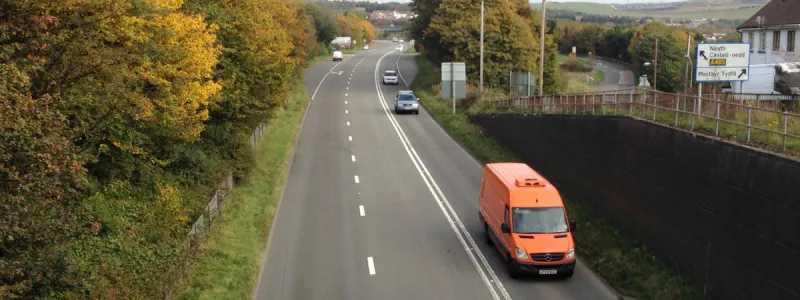The remaining two stages of the new Heads of the Valleys road would take it across the top of the valleys themselves, and to the far side of Hirwaun, from which point the existing road entered the much easier terrain in the Vale of Neath.
Stage II was to be the western section, from Dowlais Top to Hirwaun, including bypasses of both Hirwaun and Merthyr Tydfil and taking in an incredible series of bridges and viaducts. Stage III would then run from Brynmawr to Dowlais Top, linking the first two stages and completing the route.
In some ways Stage III would be the least demanding in terms of engineering, but it would also relieve some of the most tedious and indirect parts of the old road. It's largely forgotten now, but the route taken today by the A4047 through Brynmawr, Beaufort and Tredegar is the original Heads of the Valleys road, threading its way up and down steep hills through a more-or-less continuous urban area.
Stage III was made even simpler in November 1960 when the Ministry's engineers redesigned it to take advantage of a newly-closed railway line. The former railway between Merthyr Tydfil and Abergavenny had been abandoned earlier that year, and the road plan was adjusted to use about six miles of the trackbed between Dowlais Top and Rassau, west of Beaufort, making for gentler curves and gradients, and reducing the interference with private property.
The contract for Section II, Dowlais Top to Hirwaun, was let to a consortium called Christiani-Shand, made up of a group of civil engineering companies who specialised in bridge structures. That was particularly appropriate because bridge structures were present on the second section in great numbers.
This section had to thread its way around the northern fringes of Merthyr Tydfil, running 9.5 miles (15 km) of road across numerous steep crests and valleys, bridging several rivers and a reservoir in the process. The contract price reflected the scale of the task: this section was priced at £3,131,853 and was estimated to take three years to build.
The press release announcing the start of work in January 1962 boldly announced that the new road would be "33ft wide with high standards of visibility", breezily ignoring the mounting criticism that the design of the road was already facing. The whole of the new Heads of the Valleys Road would be built as a single three-lane carriageway, in a configuration common at the time but virtually unknown now that provided one lane each way and a third bi-directional lane in the middle for overtaking. It was sometimes referred to as a "suicide lane", the joke being that the lanes were left side, right side and sui-cide.
A dual carriageway was not necessary, according to the traffic surveys, and the three-lane setup would be adequate for the foreseeable future. But that didn't stop criticism pouring in, and for the whole of the years-long construction process, the local press kept up a steady trickle of articles expressing doubts over the safety of the new road.
John Morgan (Builders) Limited put in a tender for Section II, but then withdrew it, citing uncertainty over their ability to carry out the job if they won. The Ministry refunded their £25 application fee, which must have been helpful to their strained finances. The road they were building in the Clydach Gorge was turning into a quagmire.
Picture credits
- Ministry of Transport plan showing section of road to be built on railway line extracted from BD 24/341.



